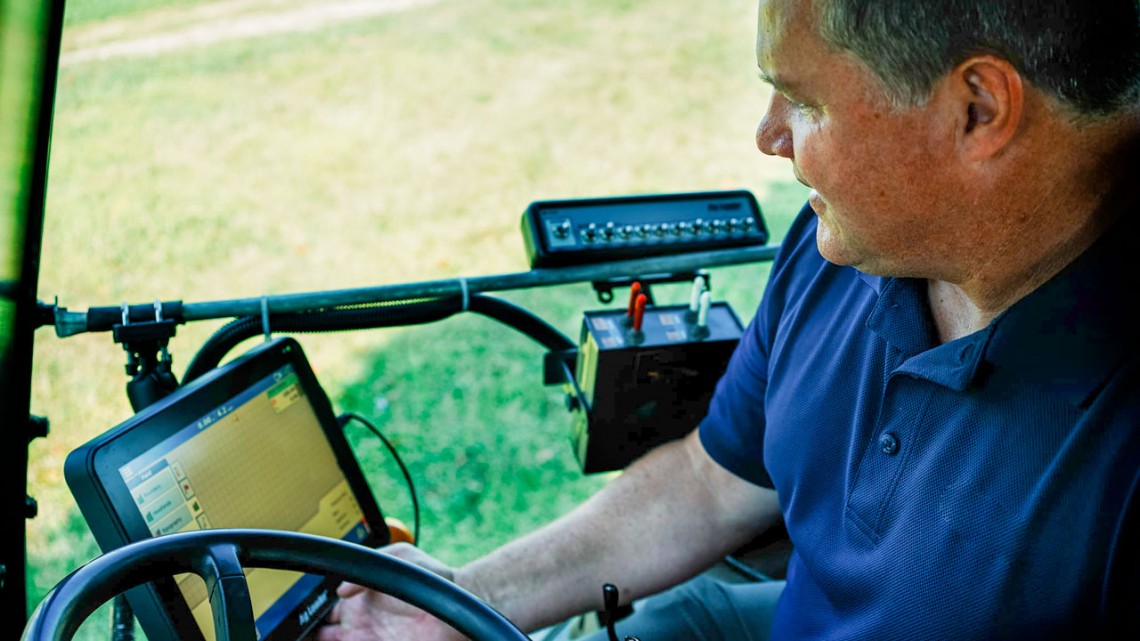
Terry Bates, senior research associate at the Cornell Lake Erie Research and Extension Laboratory, looks at efficient vineyard technology to assess field conditions.
New grant fuels better nutrient management in vineyards
By Erin Rodger
The U.S. Department of Agriculture’s National Institute of Food and Agriculture has awarded a $676,000 grant to a pair of Cornell researchers aiming to use high resolution sensors to help vineyard growers identify nutrient deficiencies.
The researchers – Terry Bates, senior research associate at the Cornell Lake Erie Research and Extension Laboratory, and Justine Vanden Heuvel, professor of horticulture – are both from the College of Agriculture and Life Sciences.
Like most plants, proper nutrient uptake is critical to vine health and fruit yield. But identifying deficiencies in nitrogen, potassium, magnesium and other key nutrients is a challenging, labor-intensive and expensive process for vineyard managers. It requires manually collecting leaves during the growing season and mailing the samples to a lab for analysis.
Not only is this costly, but in New York state, nutrient levels can vary significantly from location to location – even within a single vineyard block – due to variations in soil type. Given these challenges, growers typically opt for a one-size-fits-all approach, rather than fine-tuning their management acre by acre.
When it comes to vine nutrition, growers often end up applying fertilizers across entire vineyard blocks, instead of to the sections that need it most.
“Over-applying fertilizers like nitrogen can contribute to leaching issues, which is especially undesirable in wine regions near bodies of water,” Vanden Heuvel said. “[But] data from [our new] sensors can tell growers exactly which portions of a vineyard block need fertilizer, reducing the area that receives an application.”
Vanden Heuvel will develop a measurement mechanism that combines both ground-based sampling and satellite imaging to quantify where nutrient deficiencies are. And by doing some vineyard sampling as part of the approach, growers will effectively be doing what she calls “ground truthing” – using real numbers to support satellite measurements, ensuring that growers are getting precise information.
One of the benefits to this monitoring approach, Vanden Heuvel said, is its accessibility and affordability to grape operations of all sizes.
Bates has already been studying vineyard health through the Efficient Vineyard Project (EVP), and he will use this knowledge to develop nutrient sensors. The EVP takes soil, canopy, yield and sugar content sensing data to generate standard vineyard maps to help managers evaluate the growth, productivity and quality of plants in commercial vineyards. Growers then use this information to create more accurate maps of their own vineyards to better support their management practices.
In collaboration with Jan van Aardt, a professor at the Rochester Institute of Technology’s Center for Imaging Science, Bates will develop new proximal nutrient sensors that detect deficiencies before they become visible to field workers.
Bates and van Aardt are matching remote imaging measurements with ground measurements to set a standard for vineyard nutrition health. In combination with the sensors, this will allow growers to make real-time nutrient management decisions.
“The most important part of the project,” Bates said, “is to help growers manage vineyards more efficiently with a focus on profitability and environmental sustainability.”
Bates and Vanden Heuvel’s award is part of a total grant worth $4.75 million; collaborators on the overall grant include researchers from Washington State University, University of California at Davis, Oregon State University and the USDA Agricultural Research Service. Of the total grant, $1 million has been awarded, with the remainder contingent on the project’s progress.
Erin Rodger is the senior manager of marketing and communications for Cornell AgriTech.
Media Contact
Get Cornell news delivered right to your inbox.
Subscribe

